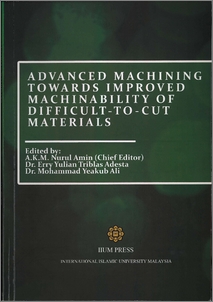Amin, A. K. M. Nurul and Hafiz, A.M. Khalid and Lajis, M. A.
(2011)
Development of tool life prediction model of TiAlN coated tools during the high speed hard milling of AISI H13 steel.
In:
Advanced Machining Towards Improved Machinability of Difficult-to-Cut Materials.
IIUM Press, Kuala Lumpur, Malaysia, pp. 155-160.
ISBN 9789674181758
![[img]](http://irep.iium.edu.my/style/images/fileicons/application_pdf.png)  Preview |
|
PDF ( Development of tool life prediction model of TiAlN coated tools during the high speed hard milling of AISI H13 steel)
- Published Version
Download (554kB)
| Preview
|
Abstract
Considering the demand for reduced cycle time and increased productivity hard turning and
milling have become a useful alternative when high material removal rate is an immense
requirement. Advantages in hard machining incorporate the complete machining process with a
single fixture setup, eliminating intermediate heat treatment and final grinding process while still
meeting the dimensional and surface roughness specifications [1].
Over the last decade high speed machining has been used extensively to produce mould and die
from hardened material like AISI H13 tool steel. Many progressive works have been carried out
to improve the high speed machining performance of H13. Despite the widespread adoption of
milling process in fabricating mould and die, most of the research works till to date concentrated
on hard turning.
J. J. Junz Wang & M. Y. Zheng, 2003 et al [1], illustrated the machining characteristics of AISI
H13 tool steels of hardness 41 and 20 HRC and found that the higher cutting and frictional
energies are required in the chip shearing as well as in the nose ploughing processes of the softer
tool steel. Poulachon et al. [2] , showed that the major influencing parameter on tool-wear
happens to be the presence of carbides in the steel microstructure. Ghani et al. [3] applied
Taguchi method to optimize cutting parameters in end milling of H13 steel at high speed cutting.
They found that feed and depth of cut possess the most significant effect over tool life for a given
range of cutting speed, feed and depth of cut.
Recently with the advent of new fabrication and coating technology, tool insert like TiAlN
coated carbide is receiving increasing attention from both industrial and research communities.
Coated carbide tools enjoy lower price than CBN tools, (normally used for hard machining) but
have a shorter tool life with lower material removal in comparison to PCBN.
Early prediction of tool wear during high speed machining by coated carbide is quite important
since high tool wear has an adverse effect on surface finish, which is considered to be the major
quality criterion of finished part. In this context, in present study, an appropriate model for
effective prediction of tool life has been developed during the high speed end milling of H13 tool
steel using PVD-TiAlN coated tool inserts.
RSM is a statistical method that combines design of experiments, regression analysis and
statistical inferences [4]. RSM also reduces total number of trials needed to generate the
experimental data in order to response model.
The application of RSM in machining parameter optimization was first reported to be used by
SM.Wu, 1965. Since then many researchers have been using this technique to design their
experiments and model the responses. Alauddin et al. [5] used RSM to optimise the surface
finish in end milling of Inconel 718 under dry condition. They developed contours to select a
combination of cutting speed, and feed without increasing the surface roughness. Öktem et al. [6]
incorporated RSM with developed genetic algorithm to optimize cutting parameters for better
surface quality in case of Inconel 718. S. Saikumar and M. S. Shunmugam et al. [7] also
combined RSM with differential evolution and genetic algorithms to draw a comparison between
these methods.
In current study, the model has been developed by RSM in terms of cutting speed (v), feed (f)
and axial depth of cut (a). Experimental runs were designed based on the principles of central
composite design (CCD) of RSM. Tool life data collected from the experimental trials were used
to formulate the RSM models.
Actions (login required)
 |
View Item |


 Download Statistics
Download Statistics Download Statistics
Download Statistics